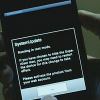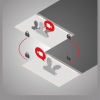Indepth analysis of The Spread of the Code-Red Worm (CRv2)
On July 19, 2001 more than 359,000 computers were infected with the Code-Red (CRv2) worm in less than 14 hours. At the peak of the infection frenzy, more than 2,000 new hosts were infected each minute. 43% of all infected hosts were in the United States, while 11% originated in Korea followed by 5% in China and 4% in Taiwan.
The .NET Top Level Domain (TLD) accounted for 19% of all compromised machines, followed by .COM with 14% and .EDU with 2%. We also observed 136 (0.04%) .MIL and 213 (0.05%) .GOV hosts infected by the worm. An animation of the geographic expansion of the worm is available...
Around 10:00 UTC in the morning of July 19th, 2001 a random seed variant of the Code-Red worm (CRv2) began to infect hosts running unpatched versions of Microsoft's IIS webserver. The worm spreads by probing random IP addresses and infecting all hosts vulnerable to the IIS exploit. As noted by others, there are at least two variants of the worm: one that used a fixed, static seed for its random number generator, and another that used a random seed. [eeye] [stuart] In this paper, we examine the characteristics of the random seed variant of Code-Red (CRv2).
This analysis covers spread of the worm during the 24 hour period beginning July 19th at midnight UTC. The data used for this preliminary study were collected from two locations: a /8 network at UCSD and two /16 networks at Lawrence Berkeley Laboratory (LBL). Two types of data from the UCSD network are used to maximize coverage of the expansion of the worm. Between midnight and 16:30 UTC, a passive network monitor recorded headers of all packets destined for the /8 research network. After 16:30 UTC, a filter installed on a campus router to reduce congestion caused by the worm blocked all external traffic to this network. Because this filter was put into place upstream of the monitor, we were unable to capture IP packet headers after 16:30 UTC. However, a second UCSD data set consisting of sampled netflow output from the filtering router was available at the UCSD site throughout the 24 hour period. Vern Paxson provided probe information collected by Bro on the LBL networks between 10:00 UTC on July 19th and 7:00 on July 20th. Unless otherwise specified, we have merged these three sources into a single dataset to produce the following results.
Host Infection Rate
We detected over 359,000 unique infected hosts in this 24-hour period. Hosts were considered to be infected if they sent TCP SYN packets on port 80 to nonexistent hosts on these networks. To determine the rate of host infection, we recorded the time of the first attempts of each infected hosts to spread the worm. Because our data represent a sample of all probes sent by infected machines, the number of hosts monitored provides a lower bound on the number of hosts that have been compromised at any given point in time. Figure 1 shows the number of infected hosts over time as monitored on the UCSD and LBL networks. The growth curve of the hosts measured with passively tapped packet headers is steepest because the monitor sees all packets destined for approximately 1/256th of the address space. The curve based on the netflow data grows more slowly because the netflow data represents a sampling of all traffic, and some flow export packets were dropped before being recorded. The LBL curve increases more slowly because although Bro monitors all packets, it observes a much smaller portion of the address space. Assuming random selection of addresses probed by infected hosts, a larger address space will be probed more often than a smaller one. All of the horizontal (no growth) segments on the curves are caused by periods in which we were unable to collect data.







































































